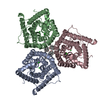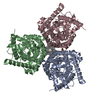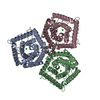+ Open data
Open data
- Basic information
Basic information
| Entry | Database: PDB / ID: 8gw6 | |||||||||||||||
|---|---|---|---|---|---|---|---|---|---|---|---|---|---|---|---|---|
| Title | AtSLAC1 6D mutant in closed state | |||||||||||||||
 Components Components | Guard cell S-type anion channel SLAC1,Green fluorescent protein (Fragment) | |||||||||||||||
 Keywords Keywords | MEMBRANE PROTEIN / Stomatal closure / anion channel / phosphorylation-dependent activation | |||||||||||||||
| Function / homology |  Function and homology information Function and homology informationinorganic anion transport / response to humidity / stomatal closure / regulation of stomatal opening / voltage-gated monoatomic anion channel activity / regulation of stomatal closure / stomatal movement / response to ozone / intracellular monoatomic ion homeostasis / response to carbon dioxide ...inorganic anion transport / response to humidity / stomatal closure / regulation of stomatal opening / voltage-gated monoatomic anion channel activity / regulation of stomatal closure / stomatal movement / response to ozone / intracellular monoatomic ion homeostasis / response to carbon dioxide / monoatomic anion transmembrane transporter activity / response to abscisic acid / multicellular organismal-level water homeostasis / organic anion transport / abscisic acid-activated signaling pathway / monoatomic anion transport / response to light stimulus / bioluminescence / generation of precursor metabolites and energy / protein phosphatase binding / protein kinase binding / membrane / plasma membrane Similarity search - Function | |||||||||||||||
| Biological species |  | |||||||||||||||
| Method | ELECTRON MICROSCOPY / single particle reconstruction / cryo EM / Resolution: 3.3 Å | |||||||||||||||
 Authors Authors | Lee, Y. / Lee, S. | |||||||||||||||
| Funding support |  Korea, Republic Of, 4items Korea, Republic Of, 4items
| |||||||||||||||
 Citation Citation |  Journal: Nat Commun / Year: 2023 Journal: Nat Commun / Year: 2023Title: Cryo-EM structures of the plant anion channel SLAC1 from Arabidopsis thaliana suggest a combined activation model. Authors: Yeongmok Lee / Hyeon Seong Jeong / Seoyeon Jung / Junmo Hwang / Chi Truc Han Le / Sung-Hoon Jun / Eun Jo Du / KyeongJin Kang / Beom-Gi Kim / Hyun-Ho Lim / Sangho Lee /  Abstract: The anion channel SLAC1 functions as a crucial effector in the ABA signaling, leading to stomata closure. SLAC1 is activated by phosphorylation in its intracellular domains. Both a binding-activation ...The anion channel SLAC1 functions as a crucial effector in the ABA signaling, leading to stomata closure. SLAC1 is activated by phosphorylation in its intracellular domains. Both a binding-activation model and an inhibition-release model for activation have been proposed based on only the closed structures of SLAC1, rendering the structure-based activation mechanism controversial. Here we report cryo-EM structures of Arabidopsis SLAC1 WT and its phosphomimetic mutants in open and closed states. Comparison of the open structure with the closed ones reveals the structural basis for opening of the conductance pore. Multiple phosphorylation of an intracellular domain (ICD) causes dissociation of ICD from the transmembrane domain. A conserved, positively-charged sequence motif in the intracellular loop 2 (ICL2) seems to be capable of sensing of the negatively charged phosphorylated ICD. Interactions between ICL2 and ICD drive drastic conformational changes, thereby widening the pore. From our results we propose that SLAC1 operates by a mechanism combining the binding-activation and inhibition-release models. | |||||||||||||||
| History |
|
- Structure visualization
Structure visualization
| Structure viewer | Molecule:  Molmil Molmil Jmol/JSmol Jmol/JSmol |
|---|
- Downloads & links
Downloads & links
- Download
Download
| PDBx/mmCIF format |  8gw6.cif.gz 8gw6.cif.gz | 229.8 KB | Display |  PDBx/mmCIF format PDBx/mmCIF format |
|---|---|---|---|---|
| PDB format |  pdb8gw6.ent.gz pdb8gw6.ent.gz | 171.1 KB | Display |  PDB format PDB format |
| PDBx/mmJSON format |  8gw6.json.gz 8gw6.json.gz | Tree view |  PDBx/mmJSON format PDBx/mmJSON format | |
| Others |  Other downloads Other downloads |
-Validation report
| Summary document |  8gw6_validation.pdf.gz 8gw6_validation.pdf.gz | 1.7 MB | Display |  wwPDB validaton report wwPDB validaton report |
|---|---|---|---|---|
| Full document |  8gw6_full_validation.pdf.gz 8gw6_full_validation.pdf.gz | 1.6 MB | Display | |
| Data in XML |  8gw6_validation.xml.gz 8gw6_validation.xml.gz | 49.8 KB | Display | |
| Data in CIF |  8gw6_validation.cif.gz 8gw6_validation.cif.gz | 69.9 KB | Display | |
| Arichive directory |  https://data.pdbj.org/pub/pdb/validation_reports/gw/8gw6 https://data.pdbj.org/pub/pdb/validation_reports/gw/8gw6 ftp://data.pdbj.org/pub/pdb/validation_reports/gw/8gw6 ftp://data.pdbj.org/pub/pdb/validation_reports/gw/8gw6 | HTTPS FTP |
-Related structure data
| Related structure data |  34303MC  8gw7C  8j0jC  8j1eC M: map data used to model this data C: citing same article ( |
|---|---|
| Similar structure data | Similarity search - Function & homology  F&H Search F&H Search |
- Links
Links
- Assembly
Assembly
| Deposited unit | 
| ||||||||||||||||||||||||||||||||||||||||||||||||||||||||||||||||||||||||||||||||||||||||||||||
|---|---|---|---|---|---|---|---|---|---|---|---|---|---|---|---|---|---|---|---|---|---|---|---|---|---|---|---|---|---|---|---|---|---|---|---|---|---|---|---|---|---|---|---|---|---|---|---|---|---|---|---|---|---|---|---|---|---|---|---|---|---|---|---|---|---|---|---|---|---|---|---|---|---|---|---|---|---|---|---|---|---|---|---|---|---|---|---|---|---|---|---|---|---|---|---|
| 1 |
| ||||||||||||||||||||||||||||||||||||||||||||||||||||||||||||||||||||||||||||||||||||||||||||||
| Noncrystallographic symmetry (NCS) | NCS domain:
NCS domain segments:
NCS oper:
|
- Components
Components
| #1: Protein | Mass: 94016.984 Da / Num. of mol.: 3 / Mutation: T62D,S65D,S107D,S124D,S146D,T152D Source method: isolated from a genetically manipulated source Source: (gene. exp.)  Gene: SLAC1, CDI3, OZS1, RCD3, At1g12480, F5O11.23, T12C24.3, gfp Plasmid: pACEBac2 / Cell line (production host): Sf9 / Production host:  #2: Chemical | #3: Chemical | Has ligand of interest | N | |
|---|
-Experimental details
-Experiment
| Experiment | Method: ELECTRON MICROSCOPY |
|---|---|
| EM experiment | Aggregation state: PARTICLE / 3D reconstruction method: single particle reconstruction |
- Sample preparation
Sample preparation
| Component | Name: Trimer of closed state AtSLAC1 6D mutant with sfGFP tag in GDN and CHS micelle Type: COMPLEX / Entity ID: #1 / Source: RECOMBINANT | ||||||||||||||||||||||||||||||
|---|---|---|---|---|---|---|---|---|---|---|---|---|---|---|---|---|---|---|---|---|---|---|---|---|---|---|---|---|---|---|---|
| Molecular weight | Value: 0.28 MDa / Experimental value: NO | ||||||||||||||||||||||||||||||
| Source (natural) | Organism:  | ||||||||||||||||||||||||||||||
| Source (recombinant) | Organism:  | ||||||||||||||||||||||||||||||
| Buffer solution | pH: 7 | ||||||||||||||||||||||||||||||
| Buffer component |
| ||||||||||||||||||||||||||||||
| Specimen | Conc.: 3.3 mg/ml / Embedding applied: NO / Shadowing applied: NO / Staining applied: NO / Vitrification applied: YES | ||||||||||||||||||||||||||||||
| Specimen support | Grid material: GOLD / Grid mesh size: 300 divisions/in. / Grid type: Quantifoil R1.2/1.3 | ||||||||||||||||||||||||||||||
| Vitrification | Instrument: FEI VITROBOT MARK III / Cryogen name: ETHANE / Humidity: 100 % / Chamber temperature: 277 K |
- Electron microscopy imaging
Electron microscopy imaging
| Experimental equipment |  Model: Titan Krios / Image courtesy: FEI Company |
|---|---|
| Microscopy | Model: TFS KRIOS |
| Electron gun | Electron source:  FIELD EMISSION GUN / Accelerating voltage: 300 kV / Illumination mode: FLOOD BEAM FIELD EMISSION GUN / Accelerating voltage: 300 kV / Illumination mode: FLOOD BEAM |
| Electron lens | Mode: BRIGHT FIELD / Nominal defocus max: 1900 nm / Nominal defocus min: 700 nm / Cs: 2.7 mm / C2 aperture diameter: 70 µm |
| Specimen holder | Cryogen: NITROGEN |
| Image recording | Electron dose: 50 e/Å2 / Film or detector model: GATAN K3 BIOQUANTUM (6k x 4k) |
| EM imaging optics | Energyfilter name: GIF Bioquantum / Energyfilter slit width: 14 eV |
- Processing
Processing
| Software |
| ||||||||||||||||||||||||
|---|---|---|---|---|---|---|---|---|---|---|---|---|---|---|---|---|---|---|---|---|---|---|---|---|---|
| EM software |
| ||||||||||||||||||||||||
| CTF correction | Type: NONE | ||||||||||||||||||||||||
| Symmetry | Point symmetry: C3 (3 fold cyclic) | ||||||||||||||||||||||||
| 3D reconstruction | Resolution: 3.3 Å / Resolution method: FSC 0.143 CUT-OFF / Num. of particles: 69390 / Algorithm: FOURIER SPACE / Symmetry type: POINT | ||||||||||||||||||||||||
| Refinement | Cross valid method: NONE | ||||||||||||||||||||||||
| Refine LS restraints |
| ||||||||||||||||||||||||
| Refine LS restraints NCS |
|
 Movie
Movie Controller
Controller






 PDBj
PDBj





